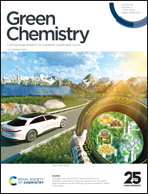Neodymium recovery from NdFeB magnets: a sustainable, instantaneous, and cost-effective method†
Abstract
Rare earth elements (REEs) are critical in modern electronics, yet sustainable, effective recovery technologies for REEs are scarce. Herein, we develop a sustainable and cost-effective neodymium (Nd) extraction technology from electronic waste using a carboxylate functionalized nanocellulose (CFNC). We demonstrate a solution-processed synthesis of CFNC from a cost-effective, readily available cellulose precursor without harsh conditions or complicated procedures. We show that Nd precipitates as Nd-CFNC complex, which can be easily separated from the solution by centrifugation. As low as 150 ppm of Nd3+ concentration is sufficient to form the precipitate instantaneously. We observe the removal of ∼252 ± 5 mg of Nd3+ per gram of CFNC, which, to our knowledge, provides the highest removal capacity at the shortest contact time of a few seconds. We explore the effect of ionic strength, pH, and temperature on the performance of CFNC. As a real-time application, we demonstrate Nd recovery from a NdFeB magnet present in waste electronic equipment. The removal using CFNC is speedy, efficient, and selective. Solar-driven electrodeposition is used to recover Nd/Nd2O3. We envision that our material will provide a low-cost, promising, sustainable technology for removing other RREs from e-waste, mines, and industrial wastewater.



 Please wait while we load your content...
Please wait while we load your content...